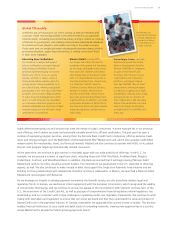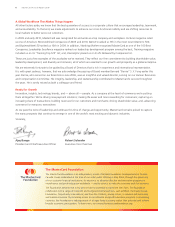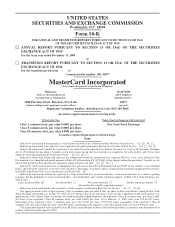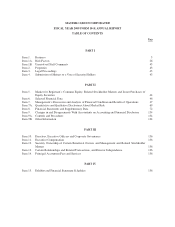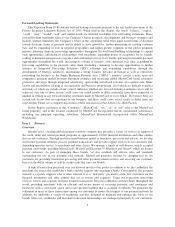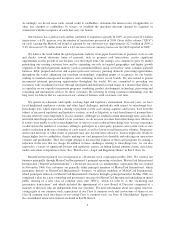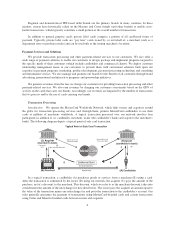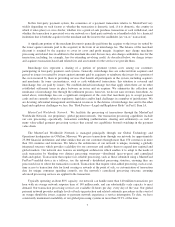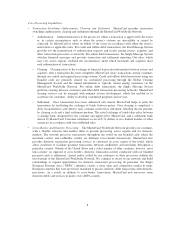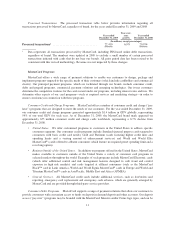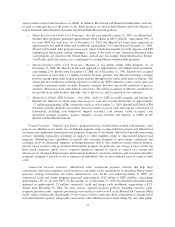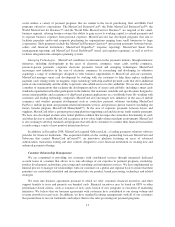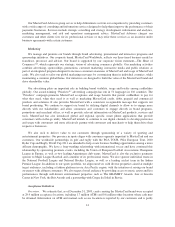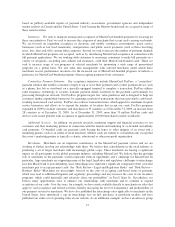MasterCard 2009 Annual Report Download - page 17
Download and view the complete annual report
Please find page 17 of the 2009 MasterCard annual report below. You can navigate through the pages in the report by either clicking on the pages listed below, or by using the keyword search tool below to find specific information within the annual report.In this four-party payment system, the economics of a payment transaction relative to MasterCard vary
widely depending on such factors as whether the transaction is domestic (and, if it is domestic, the country in
which it takes place) or cross-border, whether it is a point-of-sale purchase transaction or cash withdrawal, and
whether the transaction is processed over our network or a third party network or is handled solely by a financial
institution that is both the acquirer for the merchant and the issuer to the cardholder (an “on-us” transaction).
A significant portion of the merchant discount is generally paid from the acquirer to the issuer (or netted by
the issuer against amounts paid to the acquirer) in the form of an interchange fee. The balance of the merchant
discount is retained by the acquirer to cover its costs and profit margin. Acquirers may charge merchants
processing and related fees in addition to the merchant discount. Issuers may also charge cardholders fees for the
transaction, including, for example, fees for extending revolving credit. As described below, we charge issuers
and acquirers transaction-based and related fees and assessments for the services we provide them.
Interchange fees represent a sharing of a portion of payment system costs among our customers
participating in four-party payment card systems. Generally, interchange fees are collected from acquirers and
passed to issuers (or netted by issuers against amounts paid to acquirers) to reimburse the issuers for a portion of
the costs incurred by them in providing services that benefit all participants in the system, including acquirers
and merchants. In some circumstances, such as cash withdrawal transactions, this situation is reversed and
interchange fees are paid by issuers. We establish default interchange fees that apply when there are no other
established settlement terms in place between an issuer and an acquirer. We administer the collection and
remittance of interchange fees through the settlement process; however, we do not earn revenues from them. As
noted above, interchange fees are a significant component of the costs that merchants pay to accept payment
cards and are currently subject to regulatory, legislative and/or legal challenges in a number of jurisdictions. We
are devoting substantial management and financial resources to the defense of interchange fees and to the other
legal and regulatory challenges we face. See “Risk Factors—Legal and Regulatory Risks” in Part I, Item 1A.
MasterCard Worldwide Network. We facilitate the processing of transactions through the MasterCard
Worldwide Network, our proprietary, global payment network. Our transaction processing capabilities include
our core processing—specifically, transaction switching (authorization, clearing and settlement)—as well as
many value-added payment processing services that extend our capabilities beyond switching in the payment
value chain.
The MasterCard Worldwide Network is managed principally through our Global Technology and
Operations headquarters in O’Fallon, Missouri. We process transactions through our network for approximately
23,000 financial institutions and other entities that are our customers through more than 150 currencies in more
than 210 countries and territories. We believe the architecture of our network is unique, featuring a globally
integrated structure which provides scalability for our customers and enables them to expand into regional and
global markets. Our network also features an intelligent architecture which enables it to adapt to the needs of
each transaction by blending two distinct processing structures—distributed (peer-to-peer) and centralized
(hub-and-spoke). Transactions that require fast, reliable processing, such as those submitted using a MasterCard
PayPass®-enabled device in a tollway, use the network’s distributed processing structure, ensuring they are
processed close to where the transaction occurred. Transactions that require value-added processing, such as real-
time access to transaction data for fraud scoring or rewards at the point of sale, or customization of transaction
data for unique consumer spending controls, use the network’s centralized processing structure, ensuring
advanced processing services are applied to the transaction.
Typically operating at about 80% capacity, our network can handle more than 140 million transactions per
hour with an average network response time of 140 milliseconds, and can substantially scale capacity to meet
demand. Our transaction processing services are available 24 hours per day, every day of the year. Our global
payment network provides multiple levels of back-up protection and related continuity procedures in the event of
an outage should the issuer, acquirer or payment network experience a service interruption. To date, we have
consistently maintained availability of our global processing systems in more than 99.9% of the time.
7


